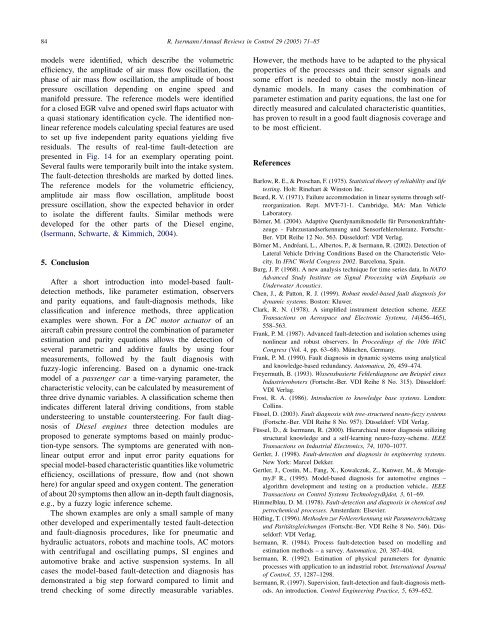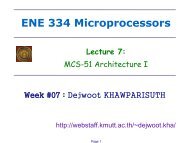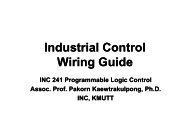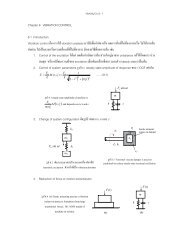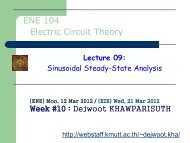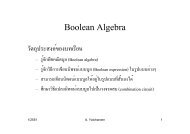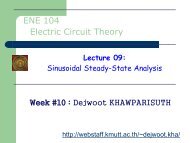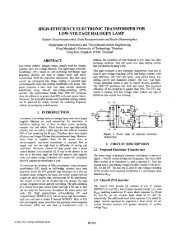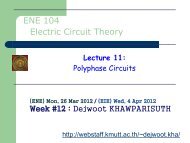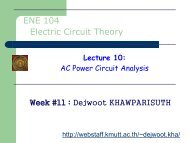Model-based fault-detection and diagnosis ... - web page for staff
Model-based fault-detection and diagnosis ... - web page for staff
Model-based fault-detection and diagnosis ... - web page for staff
You also want an ePaper? Increase the reach of your titles
YUMPU automatically turns print PDFs into web optimized ePapers that Google loves.
84<br />
models were identified, which describe the volumetric<br />
efficiency, the amplitude of air mass flow oscillation, the<br />
phase of air mass flow oscillation, the amplitude of boost<br />
pressure oscillation depending on engine speed <strong>and</strong><br />
manifold pressure. The reference models were identified<br />
<strong>for</strong> a closed EGR valve <strong>and</strong> opened swirl flaps actuator with<br />
a quasi stationary identification cycle. The identified nonlinear<br />
reference models calculating special features are used<br />
to set up five independent parity equations yielding five<br />
residuals. The results of real-time <strong>fault</strong>-<strong>detection</strong> are<br />
presented in Fig. 14 <strong>for</strong> an exemplary operating point.<br />
Several <strong>fault</strong>s were temporarily built into the intake system.<br />
The <strong>fault</strong>-<strong>detection</strong> thresholds are marked by dotted lines.<br />
The reference models <strong>for</strong> the volumetric efficiency,<br />
amplitude air mass flow oscillation, amplitude boost<br />
pressure oscillation, show the expected behavior in order<br />
to isolate the different <strong>fault</strong>s. Similar methods were<br />
developed <strong>for</strong> the other parts of the Diesel engine,<br />
(Isermann, Schwarte, & Kimmich, 2004).<br />
5. Conclusion<br />
After a short introduction into model-<strong>based</strong> <strong>fault</strong><strong>detection</strong><br />
methods, like parameter estimation, observers<br />
<strong>and</strong> parity equations, <strong>and</strong> <strong>fault</strong>-<strong>diagnosis</strong> methods, like<br />
classification <strong>and</strong> inference methods, three application<br />
examples were shown. For a DC motor actuator of an<br />
aircraft cabin pressure control the combination of parameter<br />
estimation <strong>and</strong> parity equations allows the <strong>detection</strong> of<br />
several parametric <strong>and</strong> additive <strong>fault</strong>s by using four<br />
measurements, followed by the <strong>fault</strong> <strong>diagnosis</strong> with<br />
fuzzy-logic inferencing. Based on a dynamic one-track<br />
model of a passenger car a time-varying parameter, the<br />
characteristic velocity, can be calculated by measurement of<br />
three drive dynamic variables. A classification scheme then<br />
indicates different lateral driving conditions, from stable<br />
understeering to unstable countersteering. For <strong>fault</strong> <strong>diagnosis</strong><br />
of Diesel engines three <strong>detection</strong> modules are<br />
proposed to generate symptoms <strong>based</strong> on mainly production-type<br />
sensors. The symptoms are generated with nonlinear<br />
output error <strong>and</strong> input error parity equations <strong>for</strong><br />
special model-<strong>based</strong> characteristic quantities like volumetric<br />
efficiency, oscillations of pressure, flow <strong>and</strong> (not shown<br />
here) <strong>for</strong> angular speed <strong>and</strong> oxygen content. The generation<br />
of about 20 symptoms then allow an in-depth <strong>fault</strong> <strong>diagnosis</strong>,<br />
e.g., by a fuzzy logic inference scheme.<br />
The shown examples are only a small sample of many<br />
other developed <strong>and</strong> experimentally tested <strong>fault</strong>-<strong>detection</strong><br />
<strong>and</strong> <strong>fault</strong>-<strong>diagnosis</strong> procedures, like <strong>for</strong> pneumatic <strong>and</strong><br />
hydraulic actuators, robots <strong>and</strong> machine tools, AC motors<br />
with centrifugal <strong>and</strong> oscillating pumps, SI engines <strong>and</strong><br />
automotive brake <strong>and</strong> active suspension systems. In all<br />
cases the model-<strong>based</strong> <strong>fault</strong>-<strong>detection</strong> <strong>and</strong> <strong>diagnosis</strong> has<br />
demonstrated a big step <strong>for</strong>ward compared to limit <strong>and</strong><br />
trend checking of some directly measurable variables.<br />
R. Isermann / Annual Reviews in Control 29 (2005) 71–85<br />
However, the methods have to be adapted to the physical<br />
properties of the processes <strong>and</strong> their sensor signals <strong>and</strong><br />
some ef<strong>for</strong>t is needed to obtain the mostly non-linear<br />
dynamic models. In many cases the combination of<br />
parameter estimation <strong>and</strong> parity equations, the last one <strong>for</strong><br />
directly measured <strong>and</strong> calculated characteristic quantities,<br />
has proven to result in a good <strong>fault</strong> <strong>diagnosis</strong> coverage <strong>and</strong><br />
to be most efficient.<br />
References<br />
Barlow, R. E., & Proschan, F. (1975). Statistical theory of reliability <strong>and</strong> life<br />
testing. Holt: Rinehart & Winston Inc.<br />
Beard, R. V. (1971). Failure accommodation in linear systems through selfreorganization.<br />
Rept. MVT-71-1. Cambridge, MA: Man Vehicle<br />
Laboratory.<br />
Börner, M. (2004). Adaptive Querdynamikmodelle für Personenkraftfahrzeuge<br />
- Fahrzust<strong>and</strong>serkennung und Sensorfehlertoleranz. Fortschr.-<br />
Ber. VDI Reihe 12 No. 563. Düsseldorf: VDI Verlag.<br />
Börner M., Andréani, L., Albertos, P., & Isermann, R. (2002). Detection of<br />
Lateral Vehicle Driving Conditions Based on the Characteristic Velocity.<br />
In IFAC World Congress 2002. Barcelona, Spain.<br />
Burg, J. P. (1968). A new analysis technique <strong>for</strong> time series data. In NATO<br />
Advanced Study Institute on Signal Processing with Emphasis on<br />
Underwater Acoustics.<br />
Chen, J., & Patton, R. J. (1999). Robust model-<strong>based</strong> <strong>fault</strong> <strong>diagnosis</strong> <strong>for</strong><br />
dynamic systems. Boston: Kluwer.<br />
Clark, R. N. (1978). A simplified instrument <strong>detection</strong> scheme. IEEE<br />
Transactions on Aerospace <strong>and</strong> Electronic Systems, 14(456–465),<br />
558–563.<br />
Frank, P. M. (1987). Advanced <strong>fault</strong>-<strong>detection</strong> <strong>and</strong> isolation schemes using<br />
nonlinear <strong>and</strong> robust observers. In Proceedings of the 10th IFAC<br />
Congress (Vol. 4, pp. 63–68). München, Germany.<br />
Frank, P. M. (1990). Fault <strong>diagnosis</strong> in dynamic systems using analytical<br />
<strong>and</strong> knowledge-<strong>based</strong> redundancy. Automatica, 26, 459–474.<br />
Freyermuth, B. (1993). Wissensbasierte Fehlerdiagnose am Beispiel eines<br />
Industrieroboters (Fortschr.-Ber. VDI Reihe 8 No. 315). Düsseldorf:<br />
VDI Verlag.<br />
Frost, R. A. (1986). Introduction to knowledge base systems. London:<br />
Collins.<br />
Füssel, D. (2003). Fault <strong>diagnosis</strong> with tree-structured neuro-fuzzy systems<br />
(Fortschr.-Ber. VDI Reihe 8 No. 957). Düsseldorf: VDI Verlag.<br />
Füssel, D., & Isermann, R. (2000). Hierarchical motor <strong>diagnosis</strong> utilizing<br />
structural knowledge <strong>and</strong> a self-learning neuro-fuzzy-scheme. IEEE<br />
Transactions on Industrial Electronics, 74, 1070–1077.<br />
Gertler, J. (1998). Fault-<strong>detection</strong> <strong>and</strong> <strong>diagnosis</strong> in engineering systems.<br />
New York: Marcel Dekker.<br />
Gertler, J., Costin, M., Fang, X., Kowalczuk, Z., Kunwer, M., & Monajemy.F<br />
R., (1995). <strong>Model</strong>-<strong>based</strong> <strong>diagnosis</strong> <strong>for</strong> automotive engines –<br />
algorithm development <strong>and</strong> testing on a production vehicle.. IEEE<br />
Transactions on Control Systems Technologydkjdot, 3, 61–69.<br />
Himmelblau, D. M. (1978). Fault-<strong>detection</strong> <strong>and</strong> <strong>diagnosis</strong> in chemical <strong>and</strong><br />
petrochemical processes. Amsterdam: Elsevier.<br />
Höfling, T. (1996). Methoden zur Fehlererkennung mit Parameterschätzung<br />
und Paritätsgleichungen (Fortschr.-Ber. VDI Reihe 8 No. 546). Düsseldorf:<br />
VDI Verlag.<br />
Isermann, R. (1984). Process <strong>fault</strong>-<strong>detection</strong> <strong>based</strong> on modelling <strong>and</strong><br />
estimation methods – a survey. Automatica, 20, 387–404.<br />
Isermann, R. (1992). Estimation of physical parameters <strong>for</strong> dynamic<br />
processes with application to an industrial robot. International Journal<br />
of Control, 55, 1287–1298.<br />
Isermann, R. (1997). Supervision, <strong>fault</strong>-<strong>detection</strong> <strong>and</strong> <strong>fault</strong>-<strong>diagnosis</strong> methods.<br />
An introduction. Control Engineering Practice, 5, 639–652.


